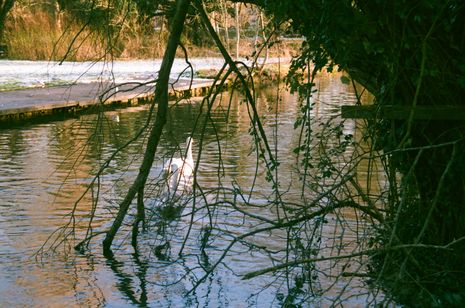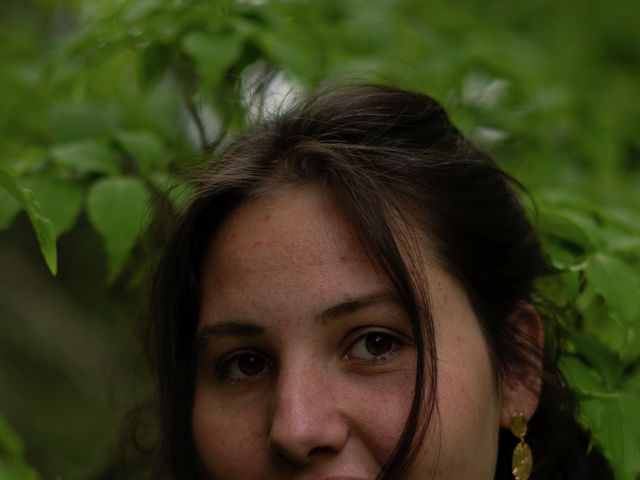Art in Public: Interventions on the Cam
In his final public art column, Tom Ward shows how the best inspiration can sometimes come from looking beyond the land

A few months before beginning my degree, my dad and I took a trip to Cambridge – he’d never visited the city before, the weather was perfect, and so we thought: why not? We arrived in town on the Park and Ride bus, and, unable to walk freely through the colleges, we thought we’d head to the river. But we didn’t use a map. Instead, we followed some chalk instructions written on the side of a wall, accompanied by an arrow, simply saying: “To the River”.
You’ve probably seen these sketches around Cambridge, notably on the corners of Trinity Lane and Garret Hostel Lane, their distinctive arrows a reminder of the Cam. They’re part of the To the River Project, a several-years-long residency program that has seen artist Caroline Wright organise events and activities designed to engage the people of Cambridge more closely with the river that binds the city together.
“It’s these connections that we have forged, and continue to forge, every day, with the water that defines the anatomy of Cambridge”
Other events that the project has spurred include Flow, which saw a tub of water taken out of the Cam at Baits Bite Lock and transported via a human chain of 81 people, using boats, kayaks, bikes and by simply swimming, all the way to Byron’s Pool; and Knit for the River, which saw members of the community knit a long chain of a thousand squares that was installed on the river by Byron’s Pool as part of efforts to stabilise the bank for conservation. Involving the local community in these projects has sought to encourage a more nuanced relationship between the town and the river, taking the form of greater awareness of river ecology and a deeper reflection upon our relations with the Cam. It’s these connections that we have forged, and continue to forge, every day, with the water that defines the anatomy of Cambridge as a city.
Art doesn’t just foster contemplation of our relationship with the river, though. If you’ve crossed the river on the curved bridge by the Museum of Technology, you’ll have probably noticed a tall red and yellow tower in the meadow on the north side of the river. Located in the nature reserve at Logan’s Meadow, S.W.I.F.T Code, by Andrew Merritt, is a commission specifically designed to attract swifts to nest in Cambridge. Its design is based on the colours of an African sunset, and the structure acts as a mechanism of both attracting swifts and offering them a place to nest. Produced partly in response to the rise in new architecture that doesn’t offer as many opportunities for nesting, the design features many points of entrance for swifts and is even optimised to keep nesting boxes cool. Critically, the commission has been successful: swifts have both nested in the tower and started to breed in the local reserve. Here, public art doesn’t just draw attention to the ecological relations we, and other species, necessarily forge with the river and its environs, but it actively intervenes in these relationships for the better.
“Public art [...] actively intervenes in these relationships for the better”
However, this is the last Art in Public column, and such a column wouldn’t be complete without drawing attention to something public art knows very well indeed: controversy. The latest, and perhaps final, iteration of the To the River project is proposed to be a site-specific, permanent installation, on the riverbank at the Mill Pond. Selvedge will be a reflective, almost gold (though more like the colour of oil in a puddle) installation of sheet metal, producing a seamless transition from land to water. Although the intention of the work is both to improve the appearance of the existing bank and prevent further erosion, it has drawn criticism from the local community because of its cost. Coming in at a prospective cost of up to £150,000, it has reignited the recurrent debate of late over whether we should be paying such a sum for a work of public art. In this case, as in many urban commissions, the funds are derived from a Section 106 legal agreement – once the money is ringfenced, it must be spent on public art.
There are many valid objections to the commission – some have argued that it should be in a different ward, where other communities would benefit more, others have suggested the ringfencing should have waited until the results of a public consultation. If you walk along the river by the Mill Pond, you’ll see laminated paper flyers on the railings outlining some of these views. However, the Section 106 funding is earmarked and the essence of the project is to reflect on the river – there aren’t a great number of places in Cambridge where such a commission could, practically speaking, be installed, and its purpose is as pragmatic as it is aesthetic. As to whether the commission will go ahead or not? You’ll have to keep a lookout – public art really is everywhere.
 News / Clare Hall spent over £500k opposing busway 24 December 2025
News / Clare Hall spent over £500k opposing busway 24 December 2025 Comment / The ‘class’ of Cambridge24 December 2025
Comment / The ‘class’ of Cambridge24 December 2025 News / Caius mourns its tree-mendous loss23 December 2025
News / Caius mourns its tree-mendous loss23 December 2025 Comment / League tables do more harm than good26 December 2025
Comment / League tables do more harm than good26 December 2025 News / Girton JCR publishes open letter expressing solidarity with Palestine25 December 2025
News / Girton JCR publishes open letter expressing solidarity with Palestine25 December 2025









